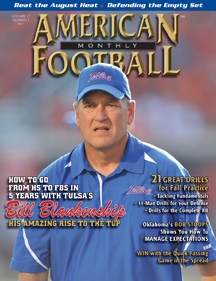Article CategoriesAFM Magazine
|
Tackling Fundamentals Teaching Progression And Circuitby: Michael HoytDefensive Coordinator • Albright College © More from this issue Vince Lombardi once said, “When a man is running down the street with everything you own, you won’t let him get away. That is tackling.” At Albright College we believe that the success of our defense rests on fundamentals. The five fundamentals of alignment, tackling, block destruction, pursuit and creating turnovers will determine the success of any defensive football team regardless of scheme. We spend a large amount of time on each of these five areas and have a plan and teaching progression for developing each area. Number one is tackling. We will share our teaching progression and drill circuit for tackling. Knowing the fundamentals of each skill is important but how we teach them is essential to our success. Tackling is not an exact science. Very rarely is a textbook tackle ever made in a football game. However, we mus....The full article can only be seen by subscribers.
|
|
|||||||
| HOME |
MAGAZINE |
SUBSCRIBE | ONLINE COLUMNISTS | COACHING VIDEOS |
Copyright 2025, AmericanFootballMonthly.com
All Rights Reserved





